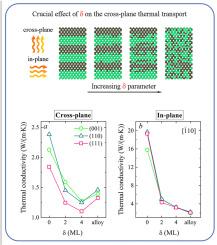By means of the Monte-Carlo/Molecular Dynamics and the non-equilibrium Molecular Dynamics methods we investigate the cross- and in-plane thermal conductivities of the (001)-, (110)- and (111)-oriented Si/Ge films (2 − 20 nm) and bulk superlattices with an intermixing at interfaces in comparison with the corresponding alloy structures at 300 K. For the first time the anomalous conductivity reduction of the in-plane thermal transport with respect to the film thickness has been revealed. This effect can be caused by interplay of three phonon scattering mechanisms: the phonon-alloy scattering mechanism, which is dominant, and competing phonon-phonon and phonon-surface scatterings due to the phonon depletion and the surface phonon localization, respectively. In general, the estimated minimal in-plane thermal conductivity values are found to be of 1.7 W/(m∙K) for the SiGe alloy thin films. It is established that the cross-plane thermal conductivity in the Si/Ge film superlattices crucially depends on intermixing at interfaces displaying even smaller values (less 1.5 W/(m∙K)) than in the corresponding SiGe alloy structures. We also show Si/SiGe superlattices in comparison with Ge/SiGe ones to provide up to 9 % gain in decreasing of both cross and in-plane thermal conductivities due to specific redistribution of peak weights in phonon density of states, which affect the thermal transport. These results reveal the insights into the application of SiGe-based superlattices and alloys for the cross- and in-plane thermoelectrics from the thermal transport minimization viewpoint.


